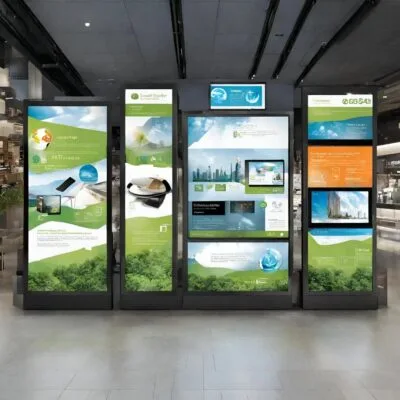The utilization of digital signage system is rapidly expanding. Following a gradual start, it is now widely embraced by restaurants, retailers, public buildings, councils, transport hubs, and various businesses. Nowadays, digital screens displaying information or advertising are widespread. The ease of readability and provision of up-to-date information are appreciated by many, yet concerns remain among individuals about the environmental impact of these screens.
This concern is shared by suppliers of digital signage solutions who have carefully worked to lessen the environmental footprint of their products. In this article, we dig into developments within the industry and beyond, highlighting some of the steps taken in this regard.
DIGITAL VS PAPER
Before delving into industry improvements, let’s first address the ongoing paper vs. digital debate that has been going on for years. There’s a common perception that favors paper advertising as more environmentally friendly than digital signage.
However, it’s crucial to consider that recycling paper still involves the consumption of fuel, electricity, and water. According to Optiwee, creating a tonne of paper using recycled materials requires approximately 840 kWh, a significant improvement from the 1,400 kWh needed for paper produced from trees. Yet, it still entails a substantial amount of electricity. The process also involves compacting paper and cardboard, consuming additional power. Additionally, the production of recycled paper consumes around 24 m3 of water, and fuel is burned during the collection and delivery process.
While recycled paper is more environmentally friendly than paper made from trees, it’s essential to recognize the considerable environmental impact of using paper advertising and information sheets.
Both Have an Impact on the Environment.
Recognizing that both paper and digital signage leave an environmental footprint, it’s clear that the materials, manufacturing, and usage of digital screens involve the extraction and transportation of materials, consuming water, fuel, and electricity.
Over recent years, efforts have been made to reduce the environmental footprint of digital screens. Let’s explore how.
Digital Screens use Less Electricity
While digital screens still consume electricity, advancements have led to a significant reduction. The best modern digital display screens now use 90% less power than their older counterparts.
Screens have Long Life
Designed for longevity, these screens can often be repaired and used for extended periods. When replacement becomes necessary, modern LED screens are far easier to recycle. Approximately 98% of the materials they consist of can be reused, prompting more businesses to actively send them for recycling.
Green Power Sources
The environmental impact of running screens can be minimized by sourcing power from green energy. Businesses adopting solar panels and utilizing waste heat from various sources contribute to the feasibility of running electrical items with minimal environmental impact.
Modern Screens Recycling Is Easy
Modern LED screens are highly recyclable, with around 98% of their materials being reusable. Businesses are increasingly verifying the recyclability of screens before purchase and actively participating in recycling efforts.
In assessing the digital vs. paper debate, it’s important to consider the context, usage, and environmental practices of businesses. Digital signage has undoubtedly become more environmentally friendly, with ongoing efforts within the industry to further enhance its ecological footprint as it evolves.
Industries That Benefit from Digital Signages
Digital Signage system continue to revolutionize various industries:
1. Transportation: providing information on routes and schedules, facilitating ticket purchases, and streamlining self-check-in at airports.
2. Healthcare: streamlining patient check-in and serving as wayfinding tools, offering facility maps and directories.
3. Retail: serving as information hubs for product details and recommendations and facilitating self-checkout for a more convenient shopping experience.
4. Hospitality: Enhancing guest experience at check-in and check-out and providing information on the hotel’s amenities and nearby attractions for a more enjoyable stay.
5. Banking and Finance: serving as information terminals and customer service points, enabling a wide range of functions such as deposits and withdrawals.
6. Restaurant Signage: Customer order processes with restaurant digital signage, increase efficiency and create an appealing dining atmosphere.”
Digital signage system is equipped with a wide range of useful features, some of which include the following:
1. Capabilities to Use Multimedia: Supporting vibrant images, 3D graphics, audio, and video, enabling businesses to showcase their brand dynamically.
2. Convenient Payment: Digital signage equipped with payment integration capabilities streamlines transaction processing. By supporting various payment methods, they ensure that transactions are convenient and secure, enhancing customer satisfaction.
3. Touchscreen Services: Facilitating user-friendly interactions for customers to access information or services smoothly.
4. Self-Service Feature: At the core of self-service terminals, allowing autonomous service delivery without the need for assistance.
5. Connected to the Internet: Digital signage has internet connectivity, allowing users to access up-to-date information, such as updated product catalogs. Users can also access real-time information such as the news, weather, and more. Similarly, internet connectivity allows users to order online and access other online services through digital signage.
6. Printers and Receipts: Digital signage equipped with receipt dispensers and printers for on-demand printing is useful in applications such as ticketing. Users can conveniently print tickets, receipts, and more to enjoy the convenience of having a tangible copy.
7. Corporate Systems Synchronization: Maximizing functionality and efficiency by synchronizing data between the digital signage and other systems and tools.
8. Scanning Barcode/QR Code: These scanners are an especially critical feature for digital kiosks as they allow users to access information quickly and more conveniently. Scanning a QR code or barcode provides instant access to information, which is more convenient than swiping through options on the interactive display.
As Nento digital signage progresses, businesses can anticipate a future marked by enhanced customer experiences and innovative technological integrations.





